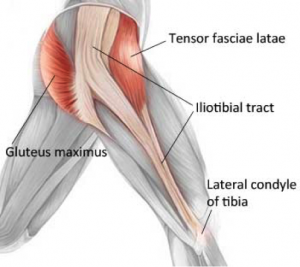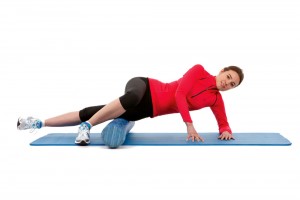Why you should NOT use a Foam Roller to Release your ITB
By Senior Massage Therapist, Anthony Evans
 The iliotibial band (ITB) is a thick sheet of connective tissue on the outside of the thigh and lies over the ITB Bursa that can become a source of pain on the outer knee, particularly in running sports.
The iliotibial band (ITB) is a thick sheet of connective tissue on the outside of the thigh and lies over the ITB Bursa that can become a source of pain on the outer knee, particularly in running sports.
We have many clients arrive in clinic who have searched “Dr Google” after getting this outside knee pain. They arrive complaining of on-going knee pain, despite their best efforts to regularly use their Foam Roller to ‘release” their ITB as prescribed by Dr Google.
Here are some facts on why you should NOT use a Foam Roller and expect your ITB pain to get better:
FACT 1: The ITB does NOT stretch. Stop trying to do it. Falvey et al 2010 measured mechanical effects of stretching on the ITB. Result: no difference; the ITB was unaffected by any type or form of stretching. Wilhelm et al confirmed these results in 2017 finding only a few mm difference when ITB was machine stretched! However, you may be able to stretch your quads muscle beneath the ITB, so focus on these instead.
FACT 2: The TFL and Glute Max muscles do contribute to ITB tension. Spend time working on these muscles attached to the ITB at the hip. Then, address movement faults that lead to the compression of the burs in the first place! See here for more information, of if you are a cyclist or runner, read more specifically here
FACT 3: The bursa/fat pad at the knee does have a lot of nerve endings. When the ITB gets taught over the top of it, it can compresses the fat pad and cause pain. Given this, the last thing we want to do is add more compression to the bursa by rolling on it! 
SO, If you’ve been heavily using a foam roller to ‘release’ your ITB, THINK AGAIN! And if you’re not seeing results from all the foam roller of your ITB, put the roller away as you may be prolonging the irritation. The only effect may be desensitisation to pummeling the tissue, not tissue elongation and release!
In summary
1. The ITB does NOT move! Don’t stretch it- although you can stretch your quads muscle that lies beneath it
2. Focus on reducing tension and tone in Glute Max and TFL muscles instead. Use a Trigger ball for these, or better yet, see a qualified Massage Therapist who understands sport and is up to date with research
3. Stop the ITB foam rolling epidemic and focus your energies on intervention that will help. If self-diagnosis and treatment is failing, see one of our experienced Physio’s in clinic.
Phone 07 5500 6470 for an appointment or Book Online
